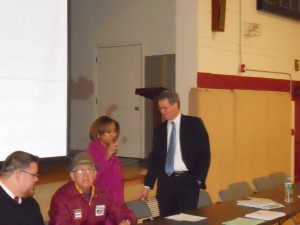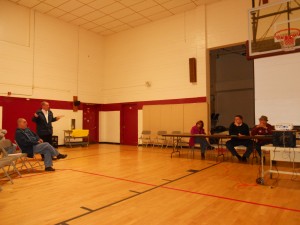Rating the City’s Values…
SPRINGFIELD—On Thursday night, the annual ritual of setting the city‘s property tax rates made its last road stop in East Forest Park. Members of the City Council’s tax-setting subcommittee and Board of Assessors Chair Richard Allen presented the city’s tax rates for the next year to a handful of residents meeting at Holy Cross’s gymnasium off Plumtree Road.
Every year municipalities in Massachusetts that set separate rates for residential and commercial properties must set the rates for each. Earlier in the year, the city assessor (or any community’s assessor) projects what the city can legally glean from taxable property. That number is plugged into the budget and then come late fall, armed with more accurate assessment of the value of taxable property, the municipality sets its rates for commercial and residential property.
Springfield, like all municipalities, must also contend with Proposition 2 ½. The thirty year old property tax law restricts municipalities ability to raise revenue. The law has two dimensions. The first, the levy limit, restricts year over year increases in the total amount of property taxes the city take in. However, any revenue due to new construction in the municipality may be added to the property tax levy independently of the annual increase.
The second, the levy ceiling, states that a municipality may not exact more than 2 ½ percent of the full fair cash value of taxable property in taxes. This is by far the lesser known of the two components, although the one menacing Springfield far more. A collapse in property values in Springfield has driven the ceiling down causing the city’s overall yield from property taxes to fall as well.
The subcommittee members present were Ward 5 Councilor Clodo Concepcion and Ward 8 Councilor John Lysak, the former acting as chair. Later in the hearing, Concepcion announced at-large Councilor Jimmy Ferrera’s arrival who stayed off to the side and lurked.
Documents the city handed out at the meeting showed that Springfield’s year over year decline in property values was driven by a $180 million loss in residential property values. Commercial property actually grew in value by $100 million for a net loss of $80 million. Since 2009, Springfield has lost $600 million in property value, although Allen, the City Assessor noted that that decline this year was smaller than the city had been expecting, a minor boon to the cash-strapped city.
During the hearing itself, Allen ran through most of the numbers including the changes in property values. Among the numbers he discussed was the change in property taxes over time and variations among various residential properties. Based on an analysis of those numbers, it appears that Springfield’s single family homes, two-family homes, multiple family homes and condominiums all fell at about the same rate since 2009.
The fall in residential property taxes has been caused, in part by a weak housing market and foreclosure-driven fire sale prices. However, another driving factor, at least this and last year was tornado damage. Allen said about $42.6 million in property value was lost due to the 2011 tornado. After the storm, Allen’s office worked to account for that damage and loss in value in last year’s assessment. This year, Allen reported, $24.6 million of that last value was restored to the tax rolls because of rebuilding.
The actual meeting to set the rates will take place on Monday at City Hall. The Council will set the rates during a special 5:00pm meeting. The hearings in East Forest Park, following similar hearings downtown were held to solicit public opinion (although the public is invited to Monday’s meeting). However, it was also an opportunity for the Assessor’s office to explain the intricacies of property tax law to the community.
Although rates were not set, Allen did produce a schedule or proposed rates and claim that residential rates were likely to go down. Last year the rates rose in order to maintain property tax revenue, but the city advertised that average single family home tax bills would fall. However, that decrease, for any given tax bill, was contingent on that property’s value falling, too. If the value in any individual property did not go down, the bill did not either. This year, with a rate decrease on tap, it is more likely that more tax bills will fall unless an individual property experienced a spike in value.
Only two individuals spoke. One lamented residential tax bills, and urged multiple family building be taxed as business, as they are, in effect for-profit ventures. Allen agreed, but noted that state law prohibits that. He also added that building the commercial tax base has been a priority of the city, notably through tax incremental financing (TIF), which waives some taxes in exchange for development.
Another man, identified as Hank Flebotte by the Republican, condemned the city’s largely non-discretionary budget and compared it to the federal budget. He suggested that the city go bankrupt to free it of pension obligations (which probably would not work) and busing costs (which are statutory obligations unaffected by bankruptcy).
In a display of true Springfield spirit, he declared, “This city is a sewer!”
Back on earth, the meeting wrapped up with few questions from the small crowd. During a brief interview with WMassP&I, Allen confirmed that the property values in the distributed literature factor in the values of TIF’s that have been approved in the city. That also includes much larger projects governed under a different provision of state law, that birthed Monarch Place and the Sovereign Bank Building.
Mayor Domenic Sarno released his suggested tax rates over the weekend. He proposed a residential rate of $19.71/$1000 of value and a commercial rate of $38.98/$1000 of value. Under this scenario, both classes of taxpayers would receive a rate, if not a tax bill decrease. This would largely preserve the status quo of the tax levy burden between residential and commercial owners, who, despite representing 27% of the city’s property values, pay 43% of the city’s property taxes.
The Council is not obligated to follow Sarno’s proposal and may set any pair of rates that will yield the city’s expected property tax levy.



